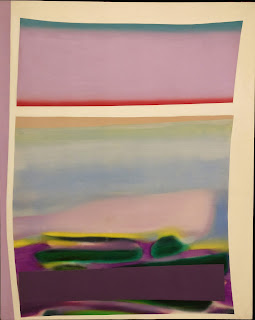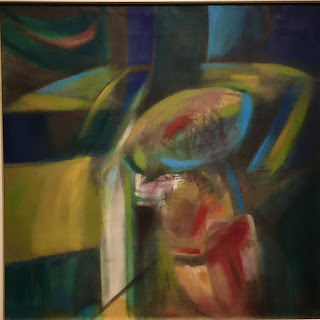Unreal GRUP (II): Dealing with Abstracts @ Sasana Kijang
At his exhibition of recent works in White Box, Publika, Jolly Koh proclaims, that “Modern Art in Malaysia is 100% foreign influence.” In the subsequent radio interview, the artist says that “this is the best show Malaysians will be able to see in a long, long time”, and “…the curator’s job is not very difficult”. The timing of Jolly’s solo show coincides with “The Unreal Deal” at Sasana Kijang, and “Gerak Rupa Ubur Penyataan 1957–1973” at ILHAM, where his earlier works are also on display. Sidestepping questions about curatorship, quality, and art history, the display of large collections of Malaysian art is still a welcome sight, insofar the interested visitor can make informed aesthetic judgements and expand one’s understanding of the Malaysian art canon. Personally, the 1960s paintings with hard-edged swathes of colours, are easily Jolly’s best work.
 |
| Jolly Koh – Road to Subang II (1969) [@ ILHAM] |
As compared to displays from the 1970s, paintings such as ‘Road to Subang II’ and ‘Wanda II’ feature unnatural forms and less conventional mix of colours. These works highlight Jolly’s composition skill in creating pictorial harmony, and remain visually relevant within Malaysian art’s current glut of painting (including the artist’s recent decorative works). Such cross-exhibition looking is the greatest joy I garnered, from abstract-themed exhibitions showing in town at the same time. Mentally oscillating between the pictures seen at Sasana Kijang then ILHAM, I conclude that Yeoh Jin Leng was uninspiring, Cheong Laitong is consistently good, Syed Ahmad Jamal was a late bloomer, and the Oxford Blue hanging at the former gallery is the best I have seen from Latiff Mohidin’s “Langkawi” series. Unfortunately, Ibrahim Hussein works presented at both places fail to impress.
 |
| Yeoh Jin Leng – Human Rot (1968) [@ ILHAM] |
Jolly recalled that only two works sold in the 1967 GRUP exhibition; Curiously, no current exhibit is indicated to be from that exhibition. 1967 was also the year Valerie Solanas published the feminist SCUM Manifesto in New York, where Ibrahim resided at the time. “The Unreal Deal”, then, is the delightful patterns by Sivam Selvaratnam, hung between works by Syed Ahmad and Laitong. Along with Sharifah Fatimah Syed Zubir, these two are the only female artists featured in this survey show. While one can suggest the link between American Abstract Expressionism and machoism as a reference point, it appears to myself as plain lazy curatorial efforts. That an explication of potential subject matter related to Malaysian abstract art – overseas education, Merdeka euphoria, collector demographics, religious teachings, Robert Rauschenberg – is entirely absent in this survey, is abysmal.
 |
| Sivam Selvaratnam – Symphony (1969) [@ Sasana Kijang] |
Twenty years ago, Wong Hoy Cheong wrote in the “reGRUP” catalogue essay, that “(t)he beliefs of these artists in the quintessential and authentic might appear archaic and naïve in this age of cyberspace and genetic cloning. However, what they propagated, formulated, and instituted were significant because for the first time in the history of the visual arts and art education, a set of reference points and pedagogic tools were made available to be appraised or debunked.” In both exhibitions, pedagogical lineage marks the continuity and relevance of abstract representation, a deficient notion given that many renown local artists are still turning out homogenous works for frivolous collectors.
 |
| Installation snapshot of Awang Damit Ahmad: [from l to r] Essence of Culture "Ingatan Waktu Kecil (1987); E.O.C Series "Childhood Memory" (1988) [@ Sasana Kijang] |
‘The 2010s’ section presents attractive contemporary interpretations. Mesmerizing compositions and visual beauty describe mature expressions by Sabri Idrus and Hamidi Hadi. In contrast, poor choice of works (surely better material can be culled for a museum display?) by Shafarin Ghani and Yeoh Choo Kuan, under-represent the skilful approaches of both artists. The most interesting display belongs to Ajim Juxta. ‘Tugu: Gelap Misteri’ combines painting techniques seen in preceding exhibits – expressionist strokes, blended colours, splashed dots, monumental forms, geometric outlines, and ripped canvases. Ajim’s works are showcased at international art fairs and local museums, but are also found at neighbourhood cafés. Is it decorative? Is it evocative? is it ground breaking? Whatever one’s answer, the fact that Ajim’s work is categorized as abstract has absolutely nothing to do with it.

Comments
Post a Comment